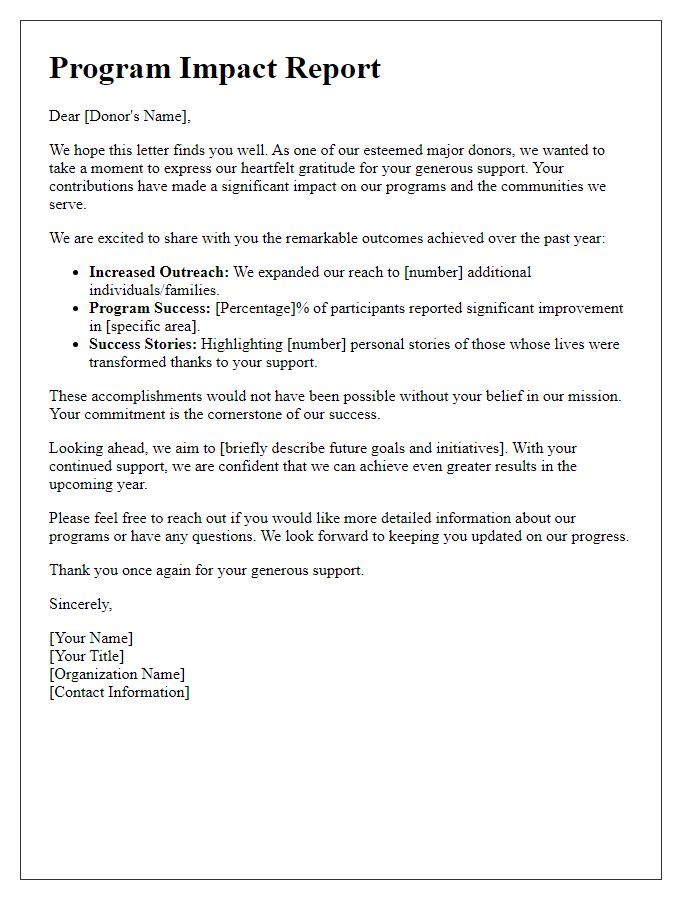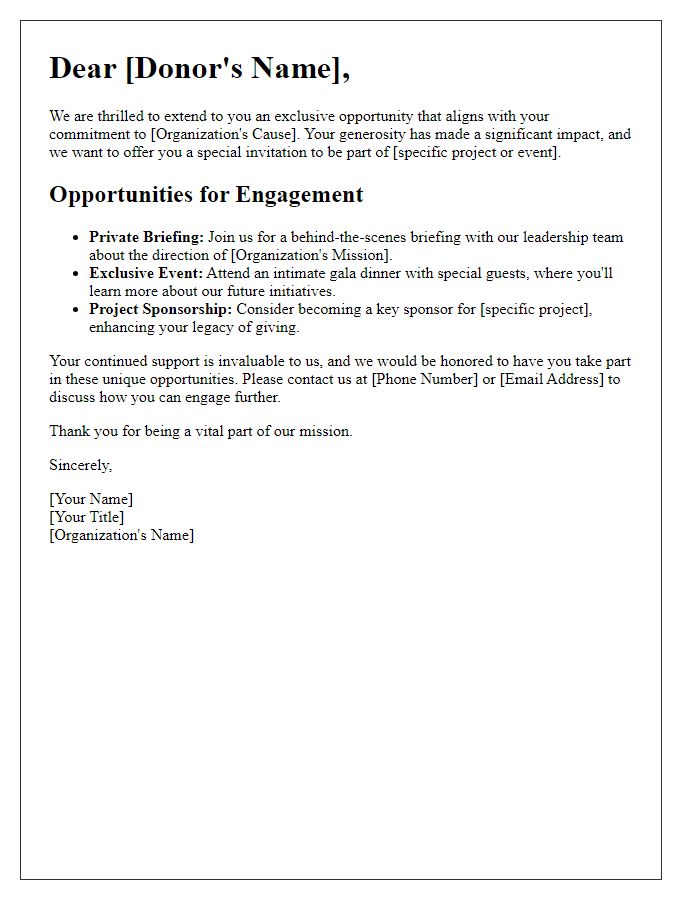Dear [Donor's Name], I hope this letter finds you well and thriving. As a valued member of our community, your generosity has played an integral role in our mission, and we are excited to share some impactful updates with you. Together, we are making significant strides toward our goals, and we want you to be part of this exciting journey. Join us in exploring the latest developments and opportunities for collaboration by reading more below!

Personalized Salutation
Personalized salutation plays a critical role in major donor cultivation, addressing the donor by name, such as "Dear Mr. John Smith" or "Dear Mrs. Linda Johnson." This personalized approach fosters a sense of connection and appreciation, emphasizing the unique relationship between the nonprofit organization and the donor. Acknowledging their past contributions or specific interests enhances the relevance of the communication, making it feel tailored to the individual. This strategy not only recognizes philanthropic values but also strengthens engagement and encourages ongoing support for the organization's mission, such as youth education or healthcare initiatives.
Gratitude and Appreciation
A significant donation can greatly impact local community initiatives, such as public education programs in Chicago, Illinois. Demonstrating gratitude toward major donors not only reinforces their commitment but also fosters long-term relationships. Personalizing communication through handwritten notes or tailored messages enhances the sincerity of appreciation. Acknowledging specific contributions, like the $50,000 funding for after-school programs, illustrates the tangible outcomes of their generosity. Events such as annual galas or donor appreciation dinners provide platforms for recognition, allowing donors to see the direct impact of their generosity while networking with like-minded philanthropists. Additionally, regular updates on program progress and success stories further cultivate a strong bond, ensuring that donors feel valued and informed.
Impactful Storytelling
Impactful storytelling engages major donors by illustrating the transformative effects of their contributions on individuals and communities. Stories can highlight specific beneficiaries, such as a young girl receiving education through scholarship programs or a family accessing healthcare services due to funding. Detailed narratives evoke emotions, demonstrating the urgency of support for ongoing projects, such as building sustainable housing in urban areas. Statistical data enhances storytelling, providing context like the percentage increase in community health outcomes or educational attainment after project implementation. Incorporating personal testimonials from those directly impacted creates a powerful connection, fostering a sense of shared purpose and urgency for potential donors.
Clear Call to Action
Major donor cultivation involves building strong relationships with influential supporters who can significantly impact an organization's mission. Effective strategies include personalized outreach, tailored engagement opportunities, and transparent communication about funding impact. Events such as exclusive receptions at renowned venues, like the Metropolitan Museum of Art in New York City, provide immersive experiences where potential donors can connect with the cause and leadership. Regular updates, detailed financial reports, and storytelling about beneficiaries create emotional connections, appealing to potential donors' philanthropic motivations. A well-crafted clear call to action, such as encouraging a donation during a matching gift campaign, can drive immediate engagement and foster long-term commitment.
Future Engagement Plans
To engage major donors more effectively, organizations can develop future engagement plans tailored to individual donor interests and motivations. This may include exclusive behind-the-scenes tours of significant projects, such as community centers in underserved areas, which can deepen their connection to the cause. Additionally, hosting intimate donor appreciation events at high-profile venues, like art galleries or historic landmarks, allows for meaningful networking opportunities among major contributors. Providing regular updates on impact metrics, such as the number of families assisted through specific programs, can resonate with donors who are results-driven. Engaging donors in strategic discussions about future initiatives, aligning with their philanthropic goals, fosters a collaborative atmosphere that encourages ongoing support. Timely follow-up communication beyond fundraising appeals, incorporating personalized thank-you notes or milestone recognition, enhances relationship-building efforts and reinforces their importance to the organization's mission.













Comments